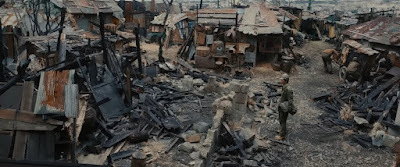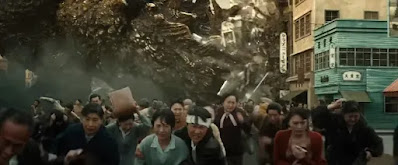or
Kurosawa's Post-War Giant Lizard Movie
Kamikazi pilot Kōichi Shikishima (Ryunosuke Kamiki) does something very unusual for a pilot of his duty. He lands his bomber on Odo Island for repairs at the remote Navy Air Service base. But, there's nothing to repair. The lead mechanic Tachibana (Munetaka Aoki) diplomatically approaches the pilot, telling him that he could find nothing apparently wrong with the plane. "What are you implying?" Shikishima replies defensively. "I'm on your side," deflects Tachibana. "You landed this bucket of bolts on this swiss-cheese of a runway. We need more people like you. Why 'die honorably?'" But, Shikishima only feels shame and regret—his very existence is evidence of his cowardice and his turning back on his duty. He is in an existential nightmare.
But, it will only get worse.
Shikishima has noticed some usually-deep-water fish dead on the surface waters surrounding Odo Island. It's an odd mystery until it gets dark. Then a roar erupts from the waves and an out-sized dinosaur creature lumbers onto the beach and quickly takes out a reconnaissance tower "Godzilla" one of the mechanics murmurs. "What is it?" Shikishima asks in terror.
"Nobody knows."And, ultimately, it doesn't matter. Shikishima will sneak to his plane, but when he has the creature in his sights, he freezes, causing a panicking technician to prematurely...and ineffectually...fire his rifle, attracting the beast's attention and provoking an attack. Shikishima runs from the plane just as Godzilla stomps on it, exploding the plane and knocking Shikishima out. When he recovers, all save for Tachibana are dead, and he accuses the pilot of cowardice, blaming the deaths on him, and vindictively giving him a packet of the dead engineers' photographs as a reminder of his weakness.
Ultimately, Shikishima returns home to Tokyo after the war, only to find it in ruins from U.S. fire-bombing, his parents dead, and his reputation as a kamikazi in tatters and himself a symbol of scorn. He does not argue, he does not fight back, as he is in utter agreement with the sentiment. He has failed in what he sees as his duty twice and his survivor's guilt is near crippling. It becomes a matter of survival, and refugees are trying to scratch out a living any way they can under U.S. occupation. It's how the young pilot becomes the care-taker of a beggar-woman, Noriko Oishi (Minami Hamabe) and the orphan-child Akiko that she has promised its dying mother to raise. But, he sees his role as merely charitable: there is no romance between Kōichi and Noriko as he does not think he deserves such happiness, nor would he disgrace Noriko by becoming her husband. For him, the war is not over. It may never be. It lives with him still.But, he needs a job. He takes one clearing the Sea of Japan of American and Japanese mines on a "specially made" ship—which turns out to be a converted wooden fishing vessel, the Shinsei Maru—the wooden structure won't attack magnetic mines, and he finds his gunnery experience useful in detonating the cut mines. With him are the ship's captain Yōji Akitsu (Kuranosuke Sasaki), Shirō Mizushima (Yuki Yamada), and former Naval engineer Kenji Noda (Hidetaka Yoshioka) and the crew form a bond, albeit a cynical one in their work of destroying the two nation's defenses.
Unbeknownst to them, the U.S. is doing further tests of the nuclear capabilities that brought Japan to its knees, and, with the war over, they're testing them on islands in the Pacific. The consequences will be far more than merely obliterating an island.This is the 70th Anniversary of the first Godzilla movie, and we should all look this good at that age. In fact, when I heard scuttlebutt that Godzilla Minus One was quite good, it went on my short-list of movies that had to be seen. Not only did it not disappoint, it is surprising how good and accomplished it is, how mature, and downright clever. It is a master-stroke that combines the kaiju tradition of Japanese monster movies with the sensibilities of the early Akiro Kurosawa post-war films filled with defeatist angst and finding the hope and courage to rise above it.
How do they do it? It's something they should have done from the beginning—move the super-imposed people at the bottom of the screen fleeing Godzilla's toes and moving them center-screen. Rather than the scientific and military perfunctories that usually do the exposition in the films, Godzilla Minus One takes to the victims of the attacks, makes their struggles real and relatable, and then "mess" with them until the audience can't take it anymore. In Godzilla Minus One, the government—such as it is—is absent, more concerned with not spreading a panic than saving lives ("Information control is Japan's specialty" says one of the heroes), and the U.S., concerned with arming the Japanese so soon after the war, and with Russia monitoring their actions in the Pacific, take no action at all. Except we send some decommissioned war-ships (we're good at that).It's up to an already-beaten-down populace to come to the fore and save themselves from a force that—like the rest of the world—just...doesn't...care. At the same time, writer-director (and SFX supervisor) Takashi Yamazaki removes the traditional sentimentality associated with this series of films and strips it from its titular monster, making it completely unfathomable and that much scarier, the stakes that much higher, and the tension that much more sphincter-tightening. Plus, his focus on the human scale of things makes the craning looks at the monster that much more impressive.
I don't "do" Top Ten lists—I find them limiting—but, if you'd tell me that a Godzilla movie would make it on my list of the top ten films of the year, I'd have laughed. I'm not laughing. I'm still kinda jazzed at how unequivocally good Godzilla Minus One is.
In fact, if you have any prejudices about going to see a "Godzilla" movie, get over them. Don't hesitate. Go. Go and enjoy. You'll be impressed.











No comments:
Post a Comment